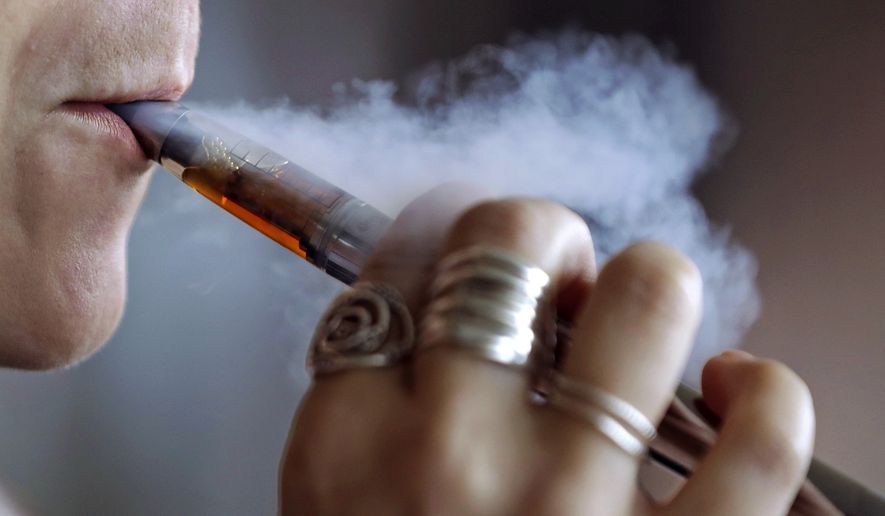OPINION:
Amid an unprecedented percentage of teens reporting that they had vaped at least once during the past month, the Trump administration was poised to announce a ban on flavors in all nicotine vaping products earlier this month. Yet after the American Medical Association and other leading health organizations urged the White House to finalize the ban, President Trump dissented and chose to delay the proposal. This prompted a temporary sigh of relief among many vaping advocates, but now the AMA is calling for a complete ban on all e-cigarette products, and many are worried about the public health implications of Mr. Trump’s impending final decision.
The flavor ban has been and will continue to be a terrible idea, but a complete prohibition would be even worse. A flavor ban would do little to address the valid concerns over youth vaping. Most chronic nicotine use is instigated by youth exposure. And while young people do prefer vaping flavors, they do at a rate not much higher than adults. Recent surveys motivating these policies seem to indicate that youth vapers would mostly substitute to whatever flavors remain legal (like potentially menthol or tobacco) instead of actually quitting e-cigarettes.
When Juul first introduced its e-cigarettes to the market in 2016, fruity flavors dominated youth e-cigarette use, but after Juul voluntarily removed most of its flavors (barring mint, menthol and tobacco) from convenience stores in 2018, youth e-cigarette use persisted to increase.
Mr. Trump’s concern over youth vaping is legitimate, but any ban would be bad for public health. Cigarette use among both teens and adults is now at its lowest rate in American history, and that has much to do with flavored e-cigarettes competing with conventional cigarettes. This isn’t surprising, as The New England Journal of Medicine has published a randomized-controlled trial showing that e-cigarettes are almost twice as effective at helping smokers quit cigarettes as FDA-approved cessation products (like nicotine gum). Public Health England also concluded that e-cigarettes are about 95 percent safer than conventional cigarettes. The evidence is clear: Public health officials should support e-cigarettes in making conventional cigarettes obsolete.
Yet for some reason, the AMA continues to support policies that would interfere with these public health promises. A flavor ban would slightly discourage vaping among youth, but it would also discourage vaping among adult smokers. Both age groups, too, would likely increase their conventional smoking rates. The BMJ, a prestigious medical publication formerly known as The British Medical Journal, published a study estimating the consequences of a flavor ban: notwithstanding additional conventional cigarette regulations, a flavor ban would reduce adult vaping by 11 percent, while increasing adult smoking by 8 percent — creating about 1.6 million additional adult smokers.
That would be unfortunate, because another study in the BMJ concluded that if conventional cigarette smokers completely switched to e-cigs, about 6.6 million fewer people would die prematurely from smoking. That’s because nicotine consumption by itself doesn’t cause most smoking-related illnesses, which we should remember while reconciling youth vaping.
And despite acknowledging the disproportionate dangers of conventional cigarettes compared to e-cigarettes in its medical journal, JAMA, the AMA wants to go even further with a full e-cigarette prohibition. But these medical leaders are ignoring a larger health crisis that such a prohibition might cause. The recent cases of vaping-related illnesses currently have little to do with legal nicotine products. Although some health officials have incorrectly conflated the lung illnesses with typical e-cigarette use, the Centers for Disease Control and Prevention have made it clear that black-market vitamin-E acetate adulteration in marijuana-derived liquids is overly responsible for the recent lung injuries. But if regulators ban all e-cigarettes (or even just the flavors that adult vapers overwhelmingly prefer) from the safe legal market, a nicotine black market and all its dangers might very well replace it.
Before the medical leaders met with the White House to endorse vaping prohibitions, I had the opportunity to ask them about whether prohibitions might incentivize black markets, and Dr. Jacqueline Fincher of the American College of Physicians replied: “The black market should not be stopping us from doing the right thing. We have laws and our government to help us protect our children, especially, and that should never stop us from doing the right thing for the right reason.”
But if “the right thing” subjects many of the current 20 million adult vapers to dangerous products on the black market, health officials might need to start addressing death instead of use. What would the Trump administration do after a flavor ban inevitably fails? It’s not quite clear, but they should resist the AMA’s calls for prohibition for the sake of public health.
• Jacob James Rich is a policy analyst at Reason Foundation and a Young Voices Consumer Freedom Fellow.




Please read our comment policy before commenting.